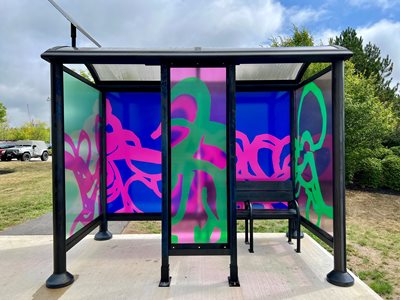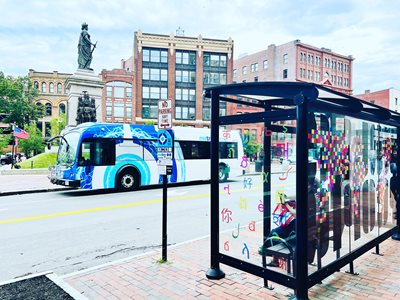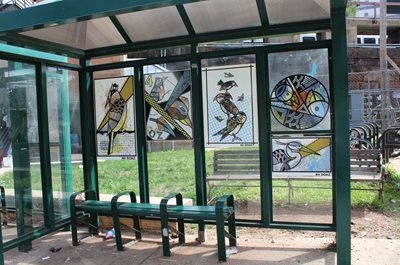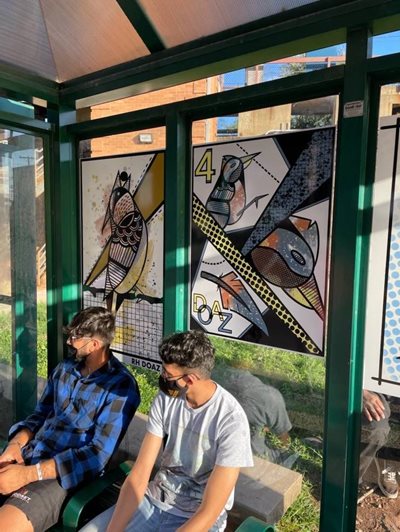.png.aspx?width=800&height=533)
Oct. 27, 2023
A BUS SHELTER can be pretty simple: essentially three walls – sometimes less – and maybe an awning. That’s like saying a house is just four walls and a roof. While that may not sound like much, the simplicity can also serve as a blank canvas.
One community getting attention for its artist-designed bus shelters is Portland, Maine, which launched a Creative Bus Shelter initiative in 2019 celebrating the diversity of the Portland landscape “economically, socially, or environmentally.” Some artists designed shelters fashioned out of cut steel while others look more like stained glass.
The initiative garnered the title of “Best Bus Stops in America” during StreetsBlog USA’s informal tournament last year, defeating the likes of bigger cities, including Baltimore and Boston. The contest celebrated funky bus shelters from Juneau, Alaska and Albany, Calif., to Minneapolis, Minn., and Norwalk, Conn.
The Streetsblog USA competition was a spin-off of its long-running, “America’s Sorriest Bus Stops” contest, designed to “highlight structural reasons why most U.S. bus stops have such inadequate amenities,” Senior Editor Kea Wilson said. She wanted to put more of a positive spin and highlight “all the awesome things communities were doing with their bus stops for a change.” The process was very informal, with Wilson choosing nominees. “The whole thing was really just for fun, and it was surprising how big the response was,” she said.
Creative Portland, the city’s nonprofit arts agency, partnered with the Greater Portland Council of Governments (GPCOG) and Greater Portland Metro on the project, which was funded with two $25,000 grants from the National Endowment for the Arts’ Our Town creative placemaking grants program.
Dinah Minot, executive director of Creative Portland, said they looked at “cool bus shelters and hubs all over the world” for inspiration. Now they’ve become a model for others. “We are attracting attention and people are asking us how to do it and looking for advice,” she said.
A video by Creative Portland explains some of the process. The pieces and locations can be found via a creative bus shelter tour on Creative Portland’s new website and cultural app. There are plans to expand the initiative with wraparound designs on buses.
Minot said the project started from the simple idea of tying public art to transportation initiatives. “At the time I was thinking some kind of sea dragons or swan boats around Portland Harbor,” she said.
They decided to focus the project on existing bus shelters, which already comply with federal Americans with Disabilities Act accessibility requirements, to help keep costs down.
“It was an affordable way to hire local artists for art in our own backyard,” she said.
Each shelter had a budget of $10,000, including $4,500 in artist fees. Creative Portland served as the project manager and helped secure donations to fulfill the grant’s matching funds requirement.
 The entire process took about two years, with the first year focused on organizing the program and recruiting artists and the second including the grant application, installation and ribbon cutting. Artists were encouraged to submit designs that celebrated the city’s diversity. They were also told the art would have to be able to withstand routine power-washing.
The entire process took about two years, with the first year focused on organizing the program and recruiting artists and the second including the grant application, installation and ribbon cutting. Artists were encouraged to submit designs that celebrated the city’s diversity. They were also told the art would have to be able to withstand routine power-washing.
About a dozen artists applied for the first round. Four shelters were completed with the initial funding and the group secured a grant to do another five, which were installed in September 2022.
The nine shelters are in heavily populated areas, where they will hopefully draw more attention to buses and encourage ridership.
“Public art on a bus shelter can reduce stigma to riding the bus. There are lots of positives that come out of that,” Minot said.
They also put thought into which artists were assigned to locations. For example, an alum of Maine College of Art was given the bus shelter near the college, which current students would see each day.
Metro took on maintenance of the art. And Minot said they’ve been lucky that there haven’t been major issues with graffiti or vandalism. One shelter had what might have been a weather-related crack in the Plexiglas panel and another had an “odd” hole.
Minot has advice for other communities interested in launching artistic bus shelter programs.
 “This is not going to happen quickly,” she warns. “You need to get community buy-in, figure out how these various designs can be designed and installed with the artist’s vision in mind, or different materials if it’s not affordable.”
“This is not going to happen quickly,” she warns. “You need to get community buy-in, figure out how these various designs can be designed and installed with the artist’s vision in mind, or different materials if it’s not affordable.”
Metro Portland had to agree to give up advertising space on its bus shelters to make the program work.
Minot said community support was also key because the grant required them to raise matching funds, or in-kind contributions, which Creative Portland hadn’t done before.
 Local businesses stepped up to help. American Aluminum and Steel provided sheets of metal, steel and laser-cutting equipment and Portland Industrial Coatings offered to powder coat the final designs to protect them from the elements. Minot said this support allowed artists to bring their visions to life.
Local businesses stepped up to help. American Aluminum and Steel provided sheets of metal, steel and laser-cutting equipment and Portland Industrial Coatings offered to powder coat the final designs to protect them from the elements. Minot said this support allowed artists to bring their visions to life.
Another challenge was supervising artists throughout the process. For many, expanding from their small studio practices to larger public art installations — at busy locations — wasn’t easy, she said.
She recommends starting small with one location, rather than several. This also makes it easier to build community support, she said.
The project involves real attention to detail and the willingness and ability to be nurturing, supportive and patient, according to Minot.
It isn’t just cities that are getting creative. In New Jersey, there’s a statewide program involving transit-related art.
 The New Jersey State Council on the Arts regularly partners with NJ TRANSIT to install art at new stations or as part of renovations. The relationship was so successful that they decided to launch the TRANSITional Art Project, to create temporary public art installations. This included featuring graphics by artist R.H. Doaz on bus shelters near the New Brunswick Train Station from September through December 2022.
The New Jersey State Council on the Arts regularly partners with NJ TRANSIT to install art at new stations or as part of renovations. The relationship was so successful that they decided to launch the TRANSITional Art Project, to create temporary public art installations. This included featuring graphics by artist R.H. Doaz on bus shelters near the New Brunswick Train Station from September through December 2022.
“Including the arts in transit spaces allows community members to encounter art in their daily lives, improving their transit experience, enhancing the communities’ culture, and reinforcing a sense of place,” said Danielle Bursk, director of community partnership & artist services at the New Jersey State Council on the Arts.
 Bursk said diverse stakeholder committees are formed to consider which artists and works to feature at each site, which has helped build support for installations.
Bursk said diverse stakeholder committees are formed to consider which artists and works to feature at each site, which has helped build support for installations.
“We very specifically include the voices of the community, stakeholders who use and work in the space, as well as arts and transit experts when making the selections,” she said. “Having a broad stakeholder base on the committee when making artist selections helps ensure the artwork included speaks to the community and is welcomed.”
More recently, NJ TRANSIT and the State Council on the Arts anounced its latest installment of The TRANSITional Art Project. “Community Arrives, Then Hope Remains,” which launched in September and will be on view until late November, includes an exterior mural, 2D illustrative art in the waiting area, and banners at the light rail station at the Walter Rand Transportation Center and light rail station in Camden.
The New Brunswick project was one of several case studies that the National Assembly of State Arts Agencies (NASAA) showcases in its Arts in Transportation: State Infrastructure Partnerships pamphlet. NASAA also features creative placemaking in Vermont, rural art programs in North Dakota, and artists-in-residence programs in Washington and Minnesota.
The brochure is a tool for other states looking to start their own programs. It offers tips for state partnerships, both on policy rationale and getting started, and recommended resources.
Mark Hrywna is editor of InTransition magazine.